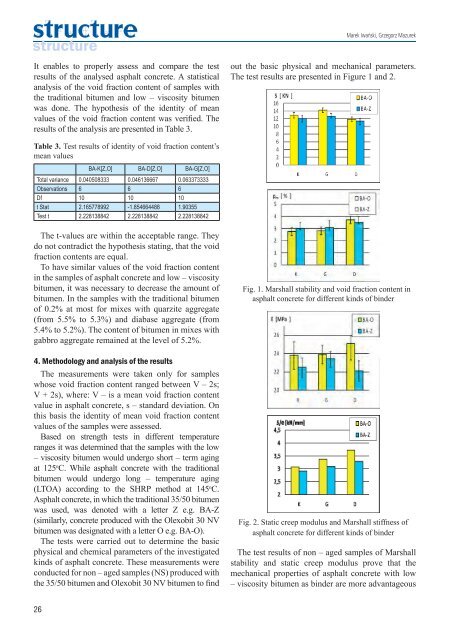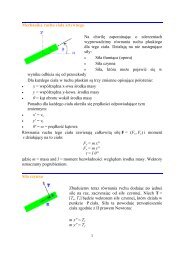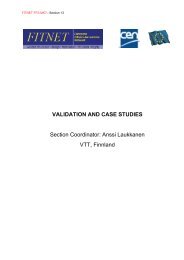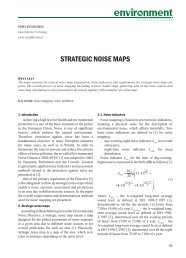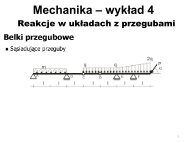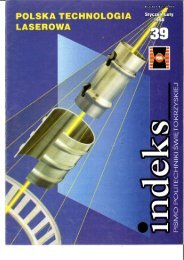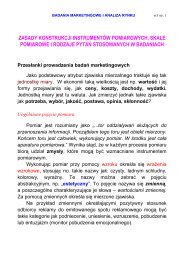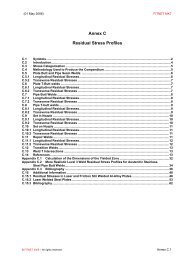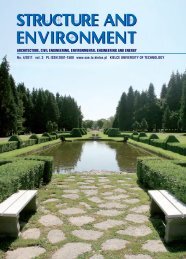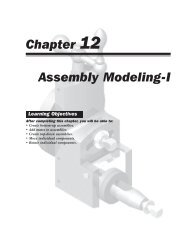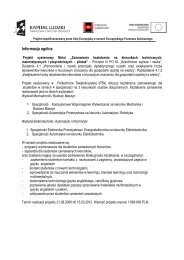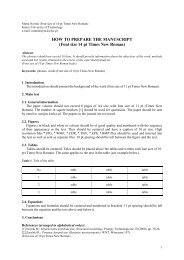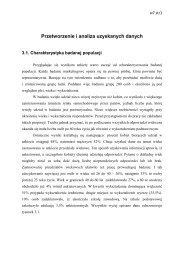Pobierz pełny numer 1/2010 S&E - Structure and Environment - Kielce
Pobierz pełny numer 1/2010 S&E - Structure and Environment - Kielce
Pobierz pełny numer 1/2010 S&E - Structure and Environment - Kielce
- No tags were found...
Create successful ePaper yourself
Turn your PDF publications into a flip-book with our unique Google optimized e-Paper software.
Marek Iwański, Grzegorz MazurekIt enables to properly assess <strong>and</strong> compare the testresults of the analysed asphalt concrete. A statisticalanalysis of the void fraction content of samples withthe traditional bitumen <strong>and</strong> low – viscosity bitumenwas done. The hypothesis of the identity of meanvalues of the void fraction content was verified. Theresults of the analysis are presented in Table 3.out the basic physical <strong>and</strong> mechanical parameters.The test results are presented in Figure 1 <strong>and</strong> 2.Table 3. Test results of identity of void fraction content’smean valuesBA-K[Z,O] BA-D[Z,O] BA-G[Z,O]Total variance 0.040508333 0.046136667 0.063373333Observations 6 6 6Df 10 10 10t Stat 2.165778992 -1.854664488 1.90355Test t 2.228138842 2.228138842 2.228138842The t-values are within the acceptable range. Theydo not contradict the hypothesis stating, that the voidfraction contents are equal.To have similar values of the void fraction contentin the samples of asphalt concrete <strong>and</strong> low – viscositybitumen, it was necessary to decrease the amount ofbitumen. In the samples with the traditional bitumenof 0.2% at most for mixes with quarzite aggregate(from 5.5% to 5.3%) <strong>and</strong> diabase aggregate (from5.4% to 5.2%). The content of bitumen in mixes withgabbro aggregate remained at the level of 5.2%.4. Methodology <strong>and</strong> analysis of the resultsThe measurements were taken only for sampleswhose void fraction content ranged between V – 2s;V + 2s), where: V – is a mean void fraction contentvalue in asphalt concrete, s – st<strong>and</strong>ard deviation. Onthis basis the identity of mean void fraction contentvalues of the samples were assessed.Based on strength tests in different temperatureranges it was determined that the samples with the low– viscosity bitumen would undergo short – term agingat 125 o C. While asphalt concrete with the traditionalbitumen would undergo long – temperature aging(LTOA) according to the SHRP method at 145 o C.Asphalt concrete, in which the traditional 35/50 bitumenwas used, was denoted with a letter Z e.g. BA-Z(similarly, concrete produced with the Olexobit 30 NVbitumen was designated with a letter O e.g. BA-O).The tests were carried out to determine the basicphysical <strong>and</strong> chemical parameters of the investigatedkinds of asphalt concrete. These measurements wereconducted for non – aged samples (NS) produced withthe 35/50 bitumen <strong>and</strong> Olexobit 30 NV bitumen to findFig. 1. Marshall stability <strong>and</strong> void fraction content inasphalt concrete for different kinds of binderFig. 2. Static creep modulus <strong>and</strong> Marshall stiffness ofasphalt concrete for different kinds of binderThe test results of non – aged samples of Marshallstability <strong>and</strong> static creep modulus prove that themechanical properties of asphalt concrete with low– viscosity bitumen as binder are more advantageous26


